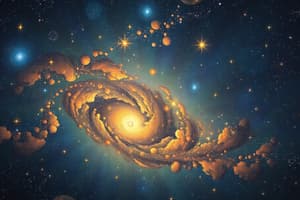Podcast
Questions and Answers
What is the main source of energy for main sequence stars?
What is the main source of energy for main sequence stars?
- Nuclear fusion of helium
- Nuclear fission
- Burning of carbon
- Nuclear fusion of hydrogen (correct)
Which type of stars mainly radiate in infrared and visible light?
Which type of stars mainly radiate in infrared and visible light?
- Main Sequence Stars
- Supernovae
- Red Dwarfs (correct)
- Red Giants
What happens to red giants when their hydrogen fuel is used up?
What happens to red giants when their hydrogen fuel is used up?
- They explode into supernovae
- They collapse into neutron stars
- They expand and cool, becoming red in color (correct)
- They become black holes
What can massive stars become after undergoing a catastrophic explosion?
What can massive stars become after undergoing a catastrophic explosion?
Which type of stars are smaller and less massive than main sequence stars?
Which type of stars are smaller and less massive than main sequence stars?
What is the initial stage of star formation?
What is the initial stage of star formation?
What is the stage between a protostar and a low-mass main sequence star?
What is the stage between a protostar and a low-mass main sequence star?
What stage do stars reach after they use up their hydrogen fuel and expand to become red giants?
What stage do stars reach after they use up their hydrogen fuel and expand to become red giants?
What can the remnants of large stars form after the supernova stage?
What can the remnants of large stars form after the supernova stage?
Which stage involves a star fusing hydrogen into helium in its core?
Which stage involves a star fusing hydrogen into helium in its core?
Flashcards are hidden until you start studying
Study Notes
Stars: Types, Star Formation, Life Cycle
Stars are celestial bodies that produce energy in the form of heat and light due to nuclear fusion in their cores. They can be found in various sizes and masses, and their life cycles depend on their specific characteristics. In this article, we will discuss the different types of stars, their formation, and the various stages of their life cycles.
Types of Stars
Stars can be classified based on their mass, size, and the fuels that power them. Some common classifications include:
-
Main Sequence Stars: These stars, such as the Sun, are in the process of using hydrogen as fuel in their cores. They generate energy through nuclear fusion, where hydrogen atoms combine to form helium.
-
Red Dwarfs: These stars are smaller and less massive than main sequence stars. They have a lower temperature and luminosity, and they mainly radiate in infrared and visible light.
-
Red Giants: These stars are larger and more massive than main sequence stars. When their hydrogen fuel is used up, they expand and cool, becoming red in color. They can then enter the red giant phase.
-
Supernovae: These stars are massive stars that can undergo a catastrophic explosion when their cores collapse. This results in the formation of neutron stars, black holes, or other celestial objects.
Star Formation
Stars form from large clouds of gas and dust called nebulae. The process of star formation can be summarized as follows:
-
Giant Gas Cloud: Stars originate from large clouds of gas, where the temperature is low enough for molecules to form.
-
Protostar: When gas particles in the molecular cloud collide, heat energy is produced, resulting in the formation of a warm clump of molecules known as a protostar.
-
T-Tauri Star: A protostar that is still undergoing gravitational contraction, representing an intermediate stage between a protostar and a low-mass main sequence star.
-
Main Sequence Star: A star that fuses hydrogen atoms to form helium in its core, with most stars in the universe being main sequence stars.
Life Cycle of Stars
The life cycle of a star can be divided into several stages, which depend on the star's size and mass:
-
Main Sequence: Stars shine brightly as they fuse hydrogen into helium in their cores. The exact lifetime of a star depends on its size, with more massive stars using up their fuel more quickly.
-
Red Giant: As stars age, they eventually use up their hydrogen fuel and expand to become red giants.
-
Planetary Nebula: In the case of small stars, they form a planetary nebula, which is a shell of ionized gas surrounding the star.
-
White Dwarf: After the hydrogen fuel is used up, a small star's core contracts and heats up, becoming a white dwarf.
-
Supernova: In the case of large stars, they can undergo a catastrophic explosion called a supernova, which scatters their material across space.
-
Neutron Star or Black Hole: The remnants of large stars can form neutron stars or black holes, which are very dense celestial objects.
In conclusion, stars are born from giant gas clouds and go through various stages in their life cycle, including main sequence, red giant, planetary nebula, and white dwarf phases. The exact duration and processes depend on the star's size and mass.
Studying That Suits You
Use AI to generate personalized quizzes and flashcards to suit your learning preferences.




